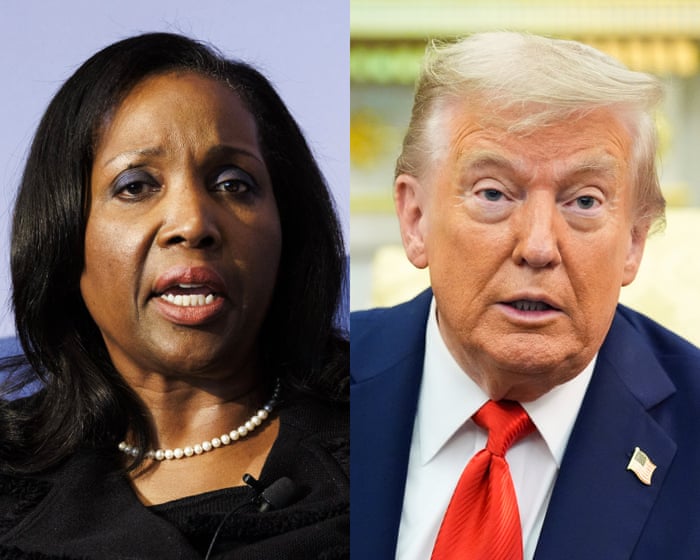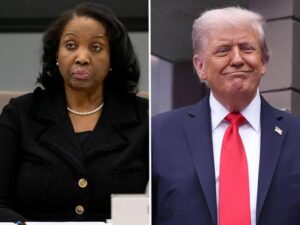Lisa Cook Survives Firing Attempt: Inside the Cook v Trump Showdown

The court will consider that the decision of a lower court in favor of Cook is to block, while his challenge for his firing by Trump continues. Today we will discuss about Lisa Cook Survives Firing Attempt: Inside the Cook v Trump Showdown
Lisa Cook Survives Firing Attempt: Inside the Cook v Trump Showdown
In the annals of American governance, few institutions are as insulated — yet as consequential — as the Federal Reserve. Tasked with steering monetary policy and managing economic stability, the institution has long been protected from direct political interference. Yet in 2025, that wall of protection was tested in dramatic fashion when former President Donald Trump attempted to remove Fed Governor Lisa Cook from office. Cook, a Biden appointee, stood her ground — and the courts intervened to block her ouster. The legal conflict, styled Cook v. Trump, has quickly become a constitutional, institutional, and political flashpoint, raising fundamental questions about presidential power, the meaning of “for cause” removal, and the independence of central banking.
This article reconstructs how the showdown unfolded, examines the legal and institutional stakes, surveys the major developments to date, and considers the potential paths ahead.
Who Is Lisa Cook — And Why Does Her Position Matter?

Lisa D. Cook is a member of the Board of Governors of the Federal Reserve System. She was first nominated by President Joe Biden in 2022, and later confirmed to a full term.
Cook’s role matters not just because she casts votes on monetary policy (e.g. interest rate decisions), but because she occupies one of the seven seats on the Fed’s Board of Governors. Her presence or absence helps determine the balance of influence and political alignment within the Fed.
Trump’s push to remove her came amid his repeated public pressure on the Fed to adopt more aggressive interest rate cuts. Analysts widely interpret the move as an attempt to reshape the Fed in a way more favorable to his policy aims.
Thus, while the immediate clash was about Cook’s dismissal, the broader conflict pits executive ambition against institutional safeguards.
The Allegations: What Triggered the Attempted Firing?
The catalyst for the conflict was a set of allegations raised in mid–2025 by Bill Pulte, head of the Federal Housing Finance Agency (FHFA), a Trump ally. Pulte claimed that Cook had misrepresented two separate properties as her “primary residence” in mortgage and loan documents in 2021 — thus allegedly obtaining more favorable mortgage terms.
In answering scrutiny, Cook’s defenders argue that the properties were properly classified (one as a vacation home or secondary home) and that her disclosure forms had been scrutinized in prior vetting processes.
Importantly, these events predated her service on the Fed board. That temporal fact underpins much of her legal defense: that misconduct prior to assuming office cannot constitute legitimate “cause” for removal under the Federal Reserve Act.
Trump’s administration countered that even if the events preceded service, the nature and materiality of the alleged misrepresentations eroded public trust — which they argue is a valid basis for removal.
Thus, the core factual dispute centers on the substance of the mortgage allegations, their timing, and their relevance to Cook’s fitness as a Fed governor.
Legal Framework: “For Cause” Removal & Institutional Independence
The Federal Reserve Act and “For Cause” Language
The Federal Reserve Act (enacted in 1913) dictates that governors may be removed by the president only “for cause.” However, the Act does not explicitly define what constitutes “cause” or provide detailed procedures for removal.
Historically, no president had ever removed a sitting Fed governor — the statute had never been judicially tested until this dispute.
This legal ambiguity means the courts now must interpret the statute’s meaning, weighing congressional intent, institutional logic, and constitutional principles.
Due Process & Judicial Review
Cook’s legal challenge emphasizes that an official with a “property interest” in a federal position (here, maintaining her term) is entitled to due process before removal. The suit argues that Cook was never given notice or an opportunity to respond before the president purported to remove her — a violation of due process.
Another core question is whether courts can block a removal (a so-called “equitable reinstatement”) or whether remedies are limited to monetary compensation (back pay) in case of wrongful termination. In earlier precedents involving other agencies, courts sometimes hesitated to second-guess executive removal of officials. But here the stakes and institutional context are higher.
The Broader Stakes: Central Bank Independence
A successful firing would mark a precedent with enormous implications: allowing a president to purge dissenting Fed voices, tilt policy outcomes, and undermine the Fed’s credibility. Many economists and former officials have warned of the perils of politicizing monetary policy — e.g., reactionary interest rate cuts tied to electoral cycles.
Consequently, the courts’ decisions in this case may set the boundaries for executive reach over independent agencies for decades.
The Courtroom Battle: Step by Step
Cook’s Lawsuit & Injunction Request
Shortly after Trump declared he was firing her (August 25, 2025), Cook responded with a lawsuit (Cook v. Trump) in the U.S. District Court for the District of Columbia. She requested a preliminary injunction to block her removal and a declaratory judgment that the firing was illegal and void.
Judge Jia M. Cobb presided over the case. On September 9, she granted a preliminary injunction, preventing the removal while the litigation proceeds. She held that Cook had made a strong showing that the attempted dismissal violated the “for cause” requirement and her due process rights.
Key elements of her reasoning:
-
The alleged misconduct predated Cook’s tenure; thus, it likely falls outside permissible “cause.”
-
The government conceded it offered Cook no meaningful opportunity to defend herself prior to removal.
-
The status quo should remain (i.e., Cook stays) until the merits are resolved to avoid destabilizing the Fed.
Appeal Court Decision
Trump’s administration sought emergency relief from the D.C. Circuit Court of Appeals to override the injunction so Cook could be removed before a Fed policy meeting. On September 15, the appellate court declined. In a 2–1 decision, it refused to permit immediate removal, thus keeping Cook in place through the ongoing litigation.
Judge Bradley Garcia (concurring) emphasized that Cook had a due process right to some minimal hearing, and since the government admitted to not providing one, granting emergency removal would upset the status quo.
The dissenting judge argued for broader presidential authority, but the majority’s decision secured Cook’s position, at least temporarily.
Supreme Court Steps In
Not satisfied with the appellate result, the Trump administration filed an emergency petition to the U.S. Supreme Court, asking the justices to stay the lower court order and permit Cook’s removal while the legal case plays out.
On October 1, 2025, the Supreme Court declined to grant immediate removal. The Court deferred action and scheduled oral arguments for January 2026. Meanwhile, Cook remains in her post.
In other words: although the Court’s brief unsigned order does not resolve the dispute, it buys time and affirms her continued service until deeper evaluation.
Why Cook “Survived” — And the Meaning of This Moment
By surviving the firing attempt — at least so far — Cook has achieved a practical victory. She stays on the board, participates in policy meetings, and avoids a disruptive leadership vacuum or legal limbo at the Fed. But more importantly, her survival underscores several deeper points:
-
Legal precedent is not lightly overridden. The judiciary, even in its most conservative iteration, showed reluctance to permit a sweeping executive action absent a full hearing.
-
Transparency and process matter. One of the most forceful threads in the case is that the administration offered no meaningful procedural safeguards before dismissal — a stark deviation from due process norms.
-
Institutional boundaries remain contested. This is not just a personal victory — it’s a test of how far the executive can push independent agencies.
-
Political symbolism is potent. Cook is the first Black woman to serve on the Fed’s board. Her defense is viewed by some as a challenge to weaponized removal tactics aimed at political opponents.
-
Uncharted constitutional terrain lies ahead. Because the statute has never been tested, the Supreme Court’s forthcoming decision may redefine removal authority across multiple federal agencies.
In short: Cook has so far held the line, but the final outcome is still undecided.
Key Legal and Policy Questions at Stake
As the case proceeds, several questions will determine not only Cook’s fate but broader doctrine:
-
What counts as “cause”? Will misconduct before assuming office qualify? Must “cause” relate to performance while in office? Must cause be narrowly defined (fraud, gross misconduct) or broadly construed (material misstatements)?
-
What procedural protections are required pre-removal? Must a trigger notice and hearing be given before removal? If so, what minimal level of procedure suffices?
-
Can courts order reinstatement, or are remedies limited to back pay? If courts are powerless to block removal, then meritless firings could be attempted with only financial consequences — undermining real independence.
-
How does the Court balance executive power with institutional guardrails? If the president can remove Fed governors too easily, political pressure may subvert monetary policy. But if removal protections are too rigid, accountability could suffer.
-
What ripple effects will this case have for other independent agencies? Agencies such as the SEC, FTC, or Federal Trade Commission might see their removal paradigms influenced by this ruling.
Possible Scenarios and Outcomes
Given how the case has progressed thus far, here are plausible outcomes and their implications:
| Scenario | What Happens | Implications |
|---|---|---|
| Supreme Court rules against Trump (limits removal authority) | Cook is fully reinstated; constraints placed on presidential ability to remove Fed governors | Cemented institutional independence, possibly restricts removal power across agencies |
| Supreme Court rules for Trump (broad removal power) | Cook might be removed; presidents can more freely reshape the Fed | Political control over central banking, markets become more attuned to White House signal |
| Compromise ruling (narrow “cause” standard + limited procedural protections) | Some control stays with the executive, but bounded by statute | Middle ground: more discipline, but not total subordination |
| Court declines to reach major doctrine (let appeals continue) | Prolonged litigation, uncertainty continues | Markets and the Fed remain in limbo about future removals |
The result may hinge on how the Court views the balance of separation of powers, administrative law, and the institutional role of the Fed.
Broader Reflections: Carbon of Power & Institutional Trust
The Cook v. Trump dispute speaks to larger tensions in modern governance:
-
Power centralization vs independent institutions: Democracies rely on autonomous institutions to check short-term political pressures. The ability to remove those who dissent risks concentrating power in the executive.
-
Rule of law over personal politics: Even political figures must observe process, not only outcomes. The case spotlights how due process serves as a restraint on arbitrary authority.
-
Trust in financial institutions: The Fed’s credibility depends on market confidence that it is guided by economic, not political, logic. A president able to purge dissenting voices undermines that credibility.
-
Erosion of norms: The move to “fire by tweet” or via executive fiat has been described by some observers as part of a broader tendency to treat institutional constraints as obstacles rather than guardrails.
-
Precedent for future fights: This case may be a template for future contests over regulators, commissions, and quasi-independent agencies.
Challenges & Critiques of Cook’s Position
While Cook has strong arguments, there are counterpoints worth considering:
-
Perceived inconsistency or omissions in her paperwork. Some documents reportedly list both properties as primary residences; critics argue that raises legitimate concern.
-
The threshold for “public trust.” Even if an allegation predates office, the standard for maintaining legitimacy as a regulator may justify more expansive cause interpretation.
-
Delay risks. Prolonged litigation can distract from the Fed’s work and create uncertainty in policy decisions.
-
Institutional norms vs bold judicial activism. Some may argue that courts should be cautious about intervening deeply in removal disputes given separation of powers concerns.
Nevertheless, the weight of precedent, process, and constitutional logic gives Cook — so far — a defensible position.
What This Means for the Fed & Markets in the Near Term
Because the Supreme Court is likely to wait until January 2026 before hearing full argument, Cook retains her seat for now — allowing her to participate in upcoming Fed meetings and rate decisions.
Markets are closely watching the case: any sign of political interference in Fed decisions could rattle confidence, destabilize rates expectations, or provoke volatility.
From a policymaking perspective, this dispute may constrain future presidents from overreaching against dissent within the Fed, or conversely embolden them if the Court decides in Trump’s favor.
Conclusion: A Vintage Moment in U.S. Institutional History
Lisa Cook’s survival (so far) in the face of an unprecedented presidential removal attempt marks a critical juncture in the evolution of American administrative law and central banking. What began as a politically charged aspiration to reshape monetary power has evolved into a constitutional test: Will presidents be permitted to purge independent voices on regulatory boards, or will statutory protections be honored?
The stakes are immense: for the Fed’s autonomy, for the doctrine of removal, and for the balance of power in Washington. As the case progresses toward oral arguments and a final ruling, both its legal reasoning and its institutional consequences will be studied for decades to come.
How useful was this post?
Click on a star to rate it!
Average rating 0 / 5. Vote count: 0
No votes so far! Be the first to rate this post.
About the Author
usa5911.com
Administrator
Hi, I’m Gurdeep Singh, a professional content writer from India with over 3 years of experience in the field. I specialize in covering U.S. politics, delivering timely and engaging content tailored specifically for an American audience. Along with my dedicated team, we track and report on all the latest political trends, news, and in-depth analysis shaping the United States today. Our goal is to provide clear, factual, and compelling content that keeps readers informed and engaged with the ever-changing political landscape.




